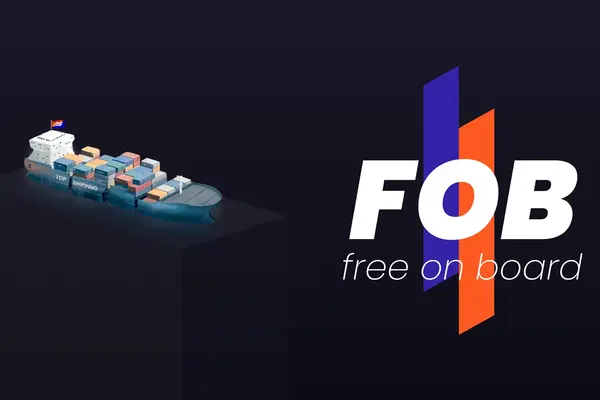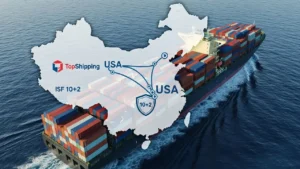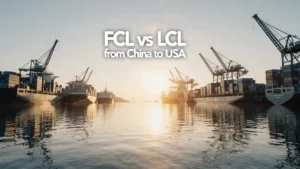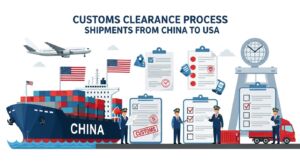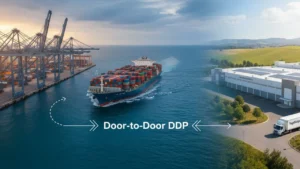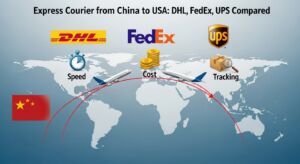Introduction
In international trade, understanding Incoterms is essential for defining responsibilities between buyers and sellers. One of the most commonly used terms in sea freight is FOB (Free on Board). It clearly outlines when the risk and cost transfer from the seller to the buyer, making it a popular choice in global shipping contracts.
Under FOB, the seller is responsible for delivering the goods onto the vessel chosen by the buyer at the named port of shipment. Once the goods are safely on board, the risk and cost transfer to the buyer, who then manages freight, insurance, and import clearance.
The FOB Incoterm provides a clear framework for exporters and importers, promoting transparency, cost efficiency, and control over the shipping process. This article explores the meaning, responsibilities, advantages, and key differences of FOB in international trade.
What Is FOB? Understanding the True FOB Meaning
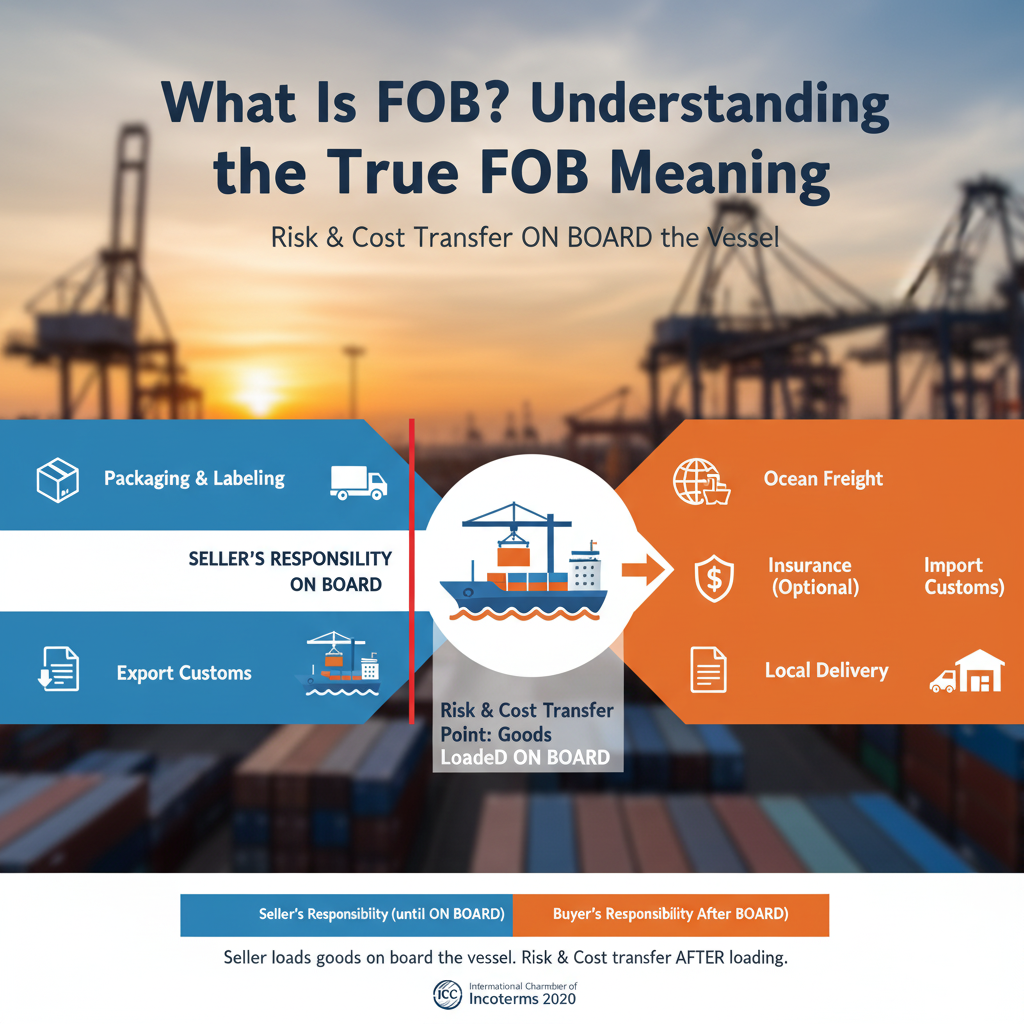
FOB (Free on Board) is one of the most widely used Incoterms in international shipping, especially for sea and inland waterway transport.
It defines the exact point at which the responsibility, cost, and risk of goods transfer from the seller to the buyer.
Under FOB, the seller’s obligation ends once the goods are loaded on the vessel chosen by the buyer at the agreed port of shipment.
From that moment, the buyer assumes all costs and risks, including ocean freight, insurance, unloading, and import customs clearance.
The key principle behind FOB is that ownership and risk transfer occur when the goods cross the ship’s rail at the port of departure.
This makes FOB ideal for buyers who want control over their freight arrangements and costs.
In short, FOB (Free on Board) provides a clear division of responsibilities:
- The seller handles export packaging, inland transport, and loading onto the ship.
- The buyer manages ocean transport, insurance, and all post-shipment costs.
This simplicity and clarity have made FOB a cornerstone term in global trade, particularly in bulk shipping and containerized freight.
FOB 2020 Update: How the Modern Incoterm Defines Global Trade?
The FOB (Free on Board) term, updated in Incoterms® 2020, remains one of the most used rules in sea trade.
Its key principle stays the same risk transfers to the buyer once the goods are loaded on the vessel.
Under the 2020 rules, FOB applies only to sea and inland waterway transport, not containerized shipping.
The seller must clear the goods for export and load them safely onto the vessel chosen by the buyer, while the buyer handles freight, insurance, and import clearance.
This update reinforces FOB’s clarity and fairness, keeping it a trusted choice for global traders who value control and cost transparency.
How FOB Shipping Works in International Trade?
In global trade, FOB (Free on Board) defines a precise sequence of actions that determine when ownership, cost, and risk move from the seller to the buyer. The process begins when the seller prepares the goods for export, ensuring all local customs documentation and quality checks are completed.
Once the goods reach the designated port, the seller’s responsibility includes loading the shipment onto the vessel chosen and paid for by the buyer. At the moment the cargo is securely placed on board, the transfer of risk officially occurs. From that point forward, the buyer takes over managing freight charges, insurance, unloading, and delivery to the final destination.
This workflow makes FOB ideal for buyers who want direct control over shipping schedules, freight rates, and insurance coverage, while allowing sellers to focus solely on preparing and exporting goods from their own country. In essence, FOB ensures that each side knows exactly when their obligations begin and end a structure that builds trust and efficiency in international trade.
FOB Price Meaning and How It’s Calculated?
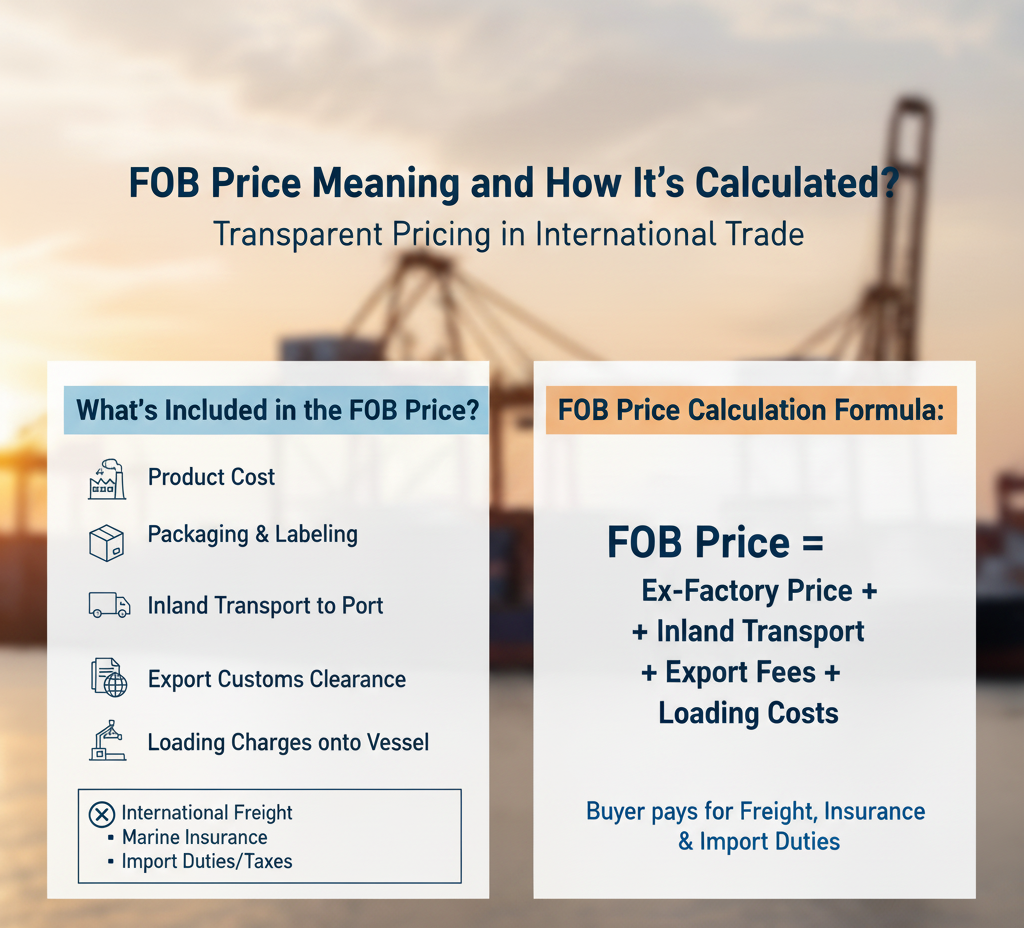
The FOB price represents the total cost of goods up to the point where they are loaded on board the vessel at the port of shipment. It includes all expenses the seller incurs before the cargo leaves the exporting country, but excludes international freight, insurance, and import costs.
In other words, the FOB price covers:
- The cost of production or purchase of the goods
- Packaging and labeling for export
- Inland transportation to the port
- Export customs clearance and related documentation
- Loading charges onto the vessel
To calculate the FOB price, exporters generally use this formula:
FOB Price = Ex-Factory Price + Inland Transport + Export Fees + Loading Costs
This pricing method allows buyers to compare offers transparently, since it separates local seller expenses from international freight charges.
For importers, knowing the FOB price helps them estimate the true landed cost once they add freight, insurance, and import duties and make informed purchasing decisions.
FOB Invoice: What It Includes and Why It Matters
An FOB invoice is a critical document in international trade, providing a detailed record of the goods being shipped and the costs the seller has covered under the FOB (Free on Board) Incoterm. This invoice is not just a financial statement it also serves as a legal proof of delivery responsibility and risk transfer.
Key elements included in an FOB invoice:
- Description of goods: Type, quantity, weight, and specifications.
- FOB price: Cost of goods up to loading on the vessel, excluding international freight, insurance, and import duties.
- Shipping details: Port of shipment, vessel name, and estimated departure date.
- Export costs: Charges for packaging, inland transport to port, customs clearance, and loading.
- Payment terms: Agreed method and schedule of payment.
Why the FOB invoice matters:
- Legal clarity: Confirms the point at which risk and responsibility transfer from seller to buyer.
- Customs clearance: Provides necessary information for both export and import authorities.
- Cost transparency: Helps the buyer calculate total landed costs by adding freight, insurance, and duties.
- Dispute prevention: Offers documented proof of agreed terms, reducing misunderstandings between parties.
In essence, an FOB invoice ensures that both buyers and sellers have a clear record of obligations, pricing, and risk allocation, making international transactions smoother and more reliable.
Seller’s Responsibilities in Delivery FOB
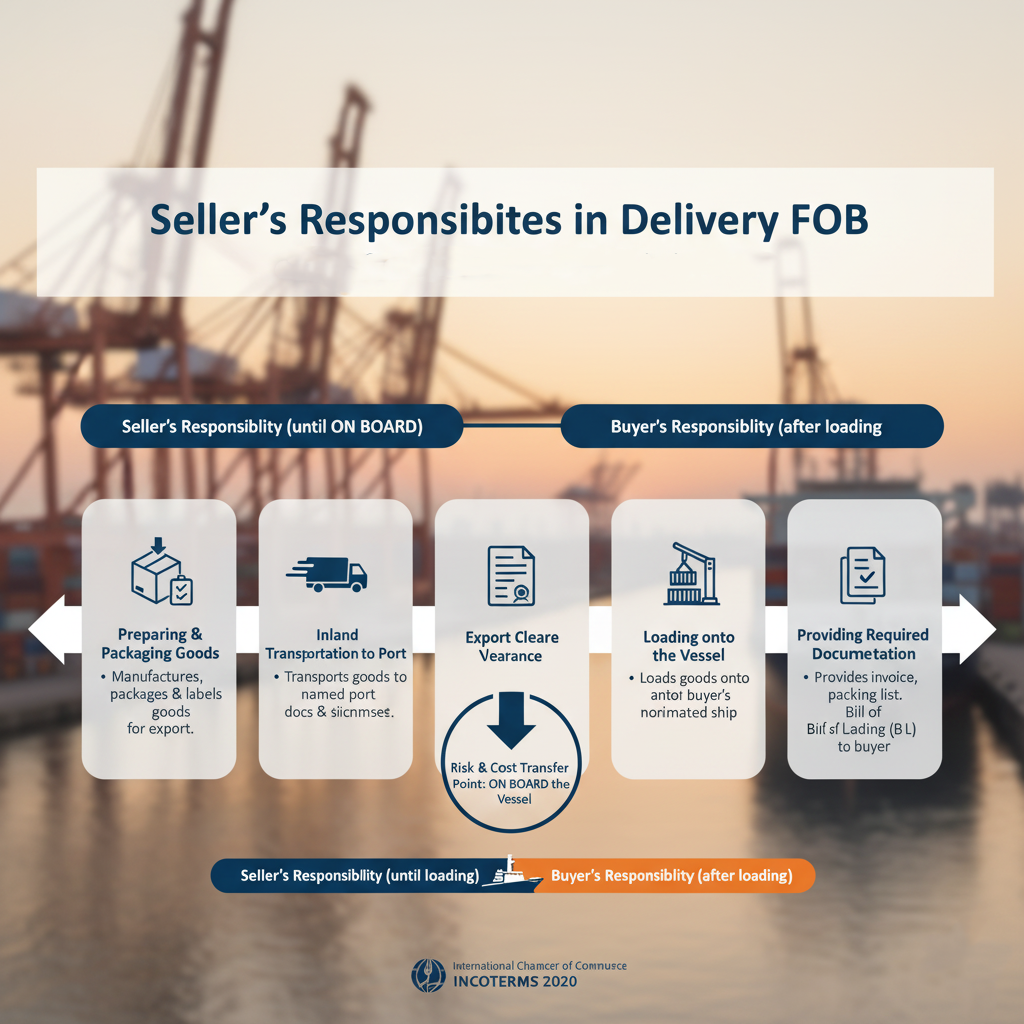
Under the FOB (Free on Board) Incoterm, the seller plays a crucial role in preparing goods for shipment and ensuring a smooth transfer of risk to the buyer. Their responsibilities include:
Preparing and Packaging Goods
The seller must ensure that the goods are properly manufactured, packaged, and labeled to meet export regulations and prevent damage during transit.
Inland Transportation to Port
Transporting the goods from the seller’s premises to the agreed port of shipment is the seller’s responsibility. This includes coordinating trucks, trains, or other local transport.
Export Clearance
The seller handles customs formalities, export documentation, and licenses, ensuring that the goods can legally leave the country.
Loading onto the Vessel
The seller must load the goods onto the vessel nominated by the buyer, taking care to follow port regulations and safety standards.
Providing Required Documentation
Essential documents such as the commercial invoice, packing list, and Bill of Lading must be delivered to the buyer to allow smooth import and payment processes.
Once the goods are safely on board, the seller’s responsibility ends, and risk transfers to the buyer. By fulfilling these duties, the seller ensures compliance with FOB terms and protects both parties from potential disputes.
Buyer’s Responsibilities under FOB Terms
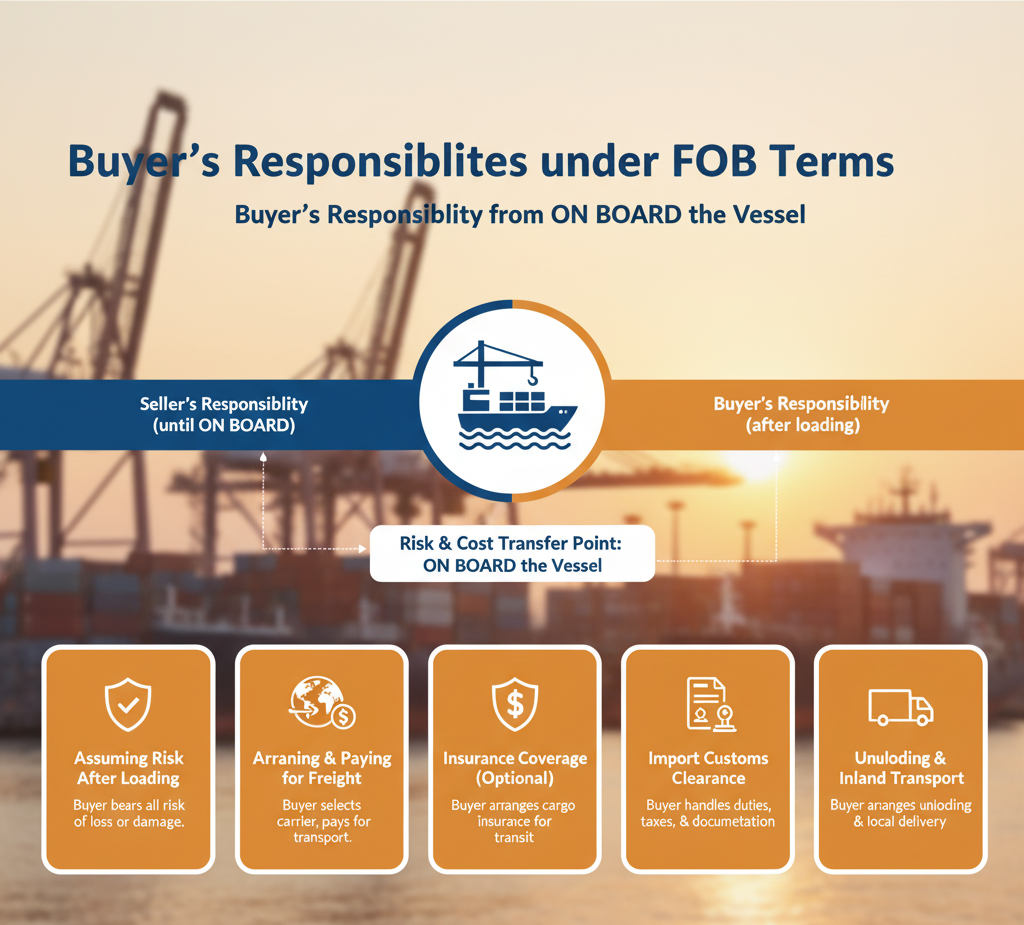
Under FOB (Free on Board), once the goods are loaded onto the vessel at the port of shipment, the buyer assumes full responsibility. Key responsibilities include:
Assuming Risk After Loading
From the moment the cargo is on board, the buyer bears all risk of loss or damage during transit.
Arranging and Paying for Freight
The buyer selects the shipping vessel and carrier, negotiates the freight rates, and covers all transportation costs from the port of shipment to the final destination.
Insurance Coverage
Unlike CIF, FOB does not include insurance. The buyer is responsible for arranging appropriate cargo insurance to protect against potential losses at sea.
Import Customs Clearance
The buyer handles all customs duties, taxes, and documentation required to import the goods into the destination country.
Unloading and Inland Transport
Upon arrival at the destination port, the buyer arranges unloading, port handling, and inland delivery to the warehouse or final location.
By fulfilling these obligations, the buyer ensures a smooth continuation of the shipment, maintains compliance with import regulations, and minimizes financial and operational risks.
Point of Cost and Risk Transfer When Ownership Changes Hands
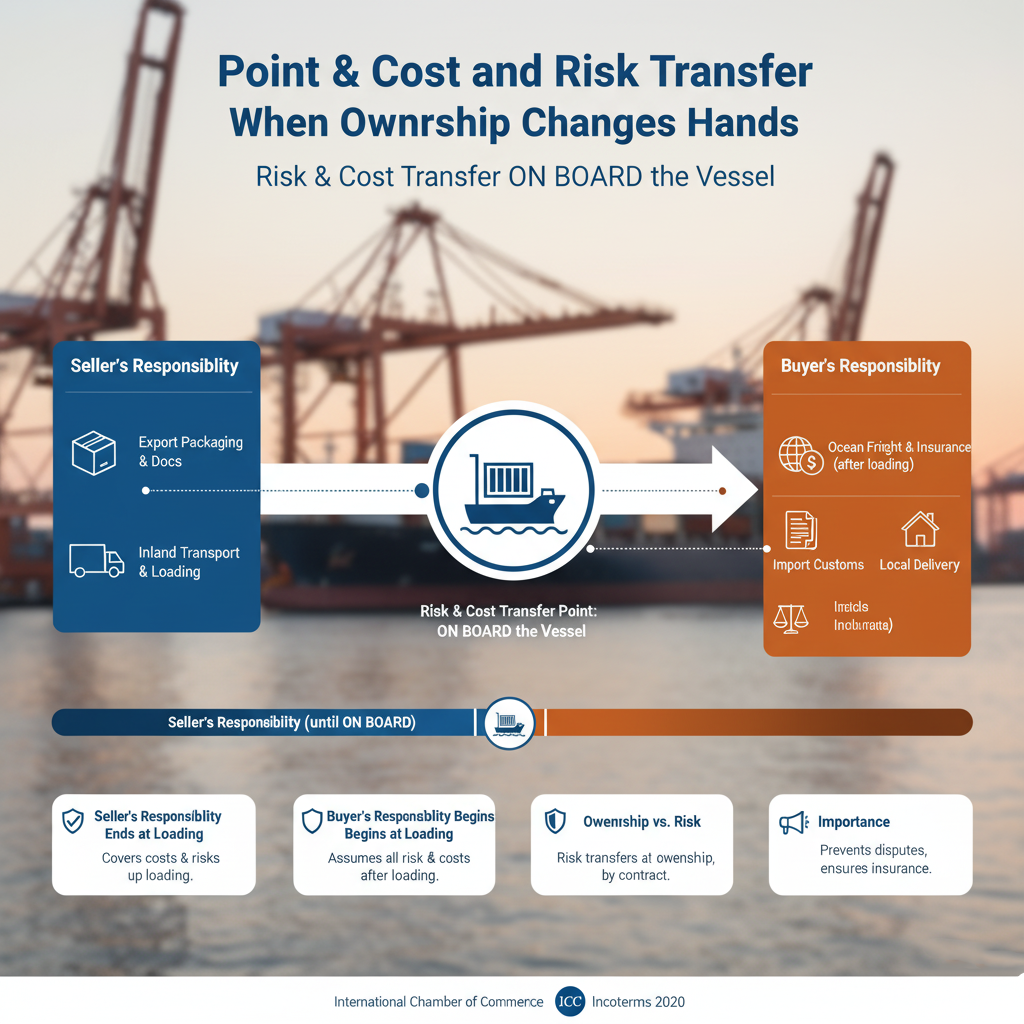
One of the most important aspects of FOB (Free on Board) is understanding when costs and risks shift from the seller to the buyer. In FOB terms, this transfer occurs precisely when the goods cross the ship’s rail at the port of shipment.
Key points to note:
- Seller’s Responsibility Ends at Loading :The seller covers all costs and risks up to the point of loading, including packaging, inland transport, export clearance, and safe placement on the vessel.
- Buyer’s Responsibility Begins at Loading :From the moment the goods are on board, the buyer assumes all risk of loss or damage. The buyer also takes over costs for ocean freight, insurance, unloading, and import customs clearance.
- Ownership vs. Risk :While the FOB term specifies risk transfer, ownership is typically governed by the sales contract. In most cases, ownership and risk transfer simultaneously at loading, but contracts may specify otherwise.
- Importance in Legal and Financial Terms :Clearly defining this transfer point helps prevent disputes, ensures proper insurance coverage, and allows both parties to plan costs and logistics efficiently.
In short, understanding the exact moment when cost and risk shift under FOB is essential for smooth international trade, protecting both the seller and buyer from unexpected liabilities.
FOB vs CIF vs CFR What’s the Difference?
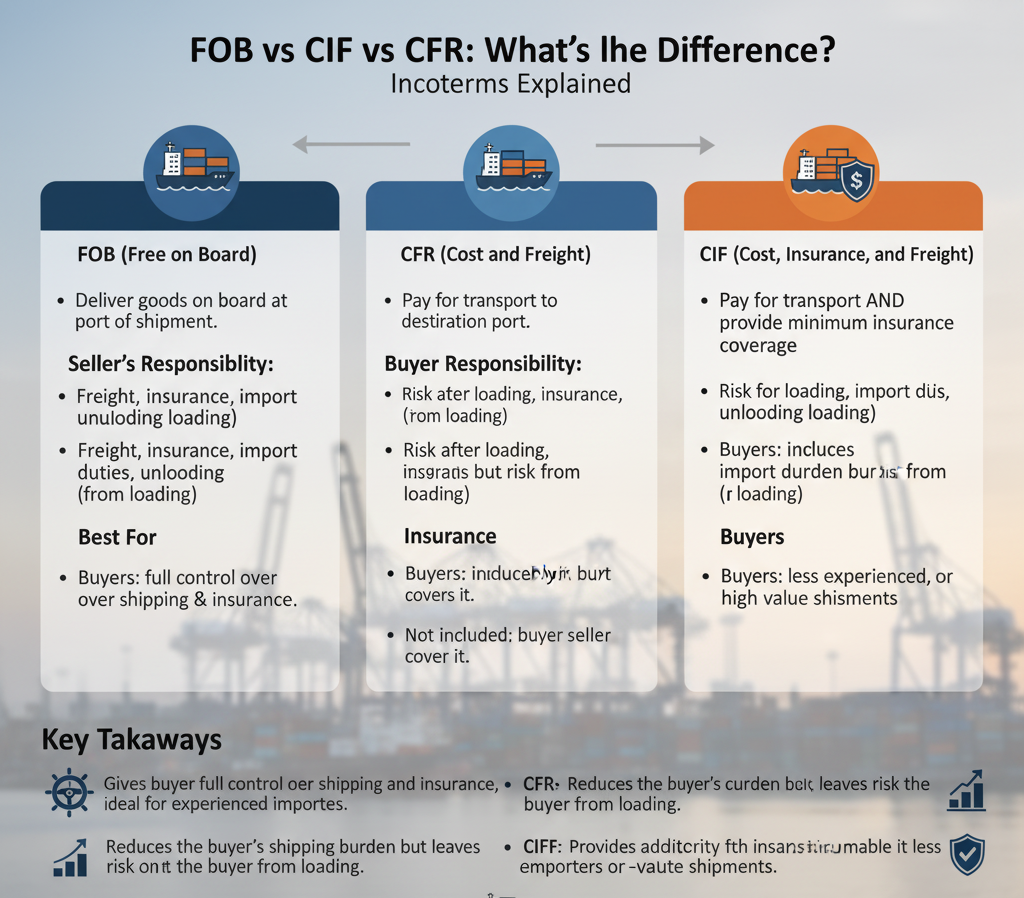
Understanding the differences between FOB (Free on Board), CIF , and CFR (Cost and Freight) is crucial for buyers and sellers in international trade. Although all three are widely used in sea freight, they differ in terms of risk, cost allocation, and insurance responsibility.
| Incoterm | Seller’s Responsibility | Buyer’s Responsibility | Insurance | Risk Transfer Point |
|---|---|---|---|---|
| FOB | Deliver goods on board at port of shipment | Freight, insurance, import duties, unloading | Buyer arranges | When goods are loaded on the vessel |
| CFR | Pay for transport to destination port | Risk after loading, insurance, import duties, unloading | Buyer arranges | When goods are loaded on the vessel |
| CIF | Pay for transport and provide minimum insurance | Risk after loading, import duties, unloading | Seller provides | When goods are loaded on the vessel |
FOB (Free on Board)
- Seller’s Responsibility: Deliver goods on board at the port of shipment.
- Buyer’s Responsibility: All costs and risks from the moment goods are loaded, including freight, insurance, and import duties.
- Insurance: Arranged by the buyer.
CFR (Cost and Freight)
- Seller’s Responsibility: Pay for transport to the destination port.
- Buyer’s Responsibility: Risk transfers once goods are on board; insurance is arranged by the buyer.
- Insurance: Not included; buyer covers it.
CIF (Cost, Insurance, and Freight)
- Seller’s Responsibility: Pay for freight to the destination port and provide minimum insurance coverage.
- Buyer’s Responsibility: Risk transfers once goods are loaded, but seller arranges basic insurance.
- Insurance: Included by the seller.
Key Takeaways:
- FOB gives the buyer full control over shipping and insurance, ideal for experienced importers.
- CFR reduces the buyer’s shipping burden but leaves risk on the buyer from loading.
- CIF (Cost, Insurance and Freight) provides additional security for the buyer with insurance included, making it suitable for less experienced importers or high value shipments.
By choosing the right Incoterm, businesses can balance cost, risk, and control according to their trade strategy and operational capacity.
Advantages and Disadvantages of Using FOB
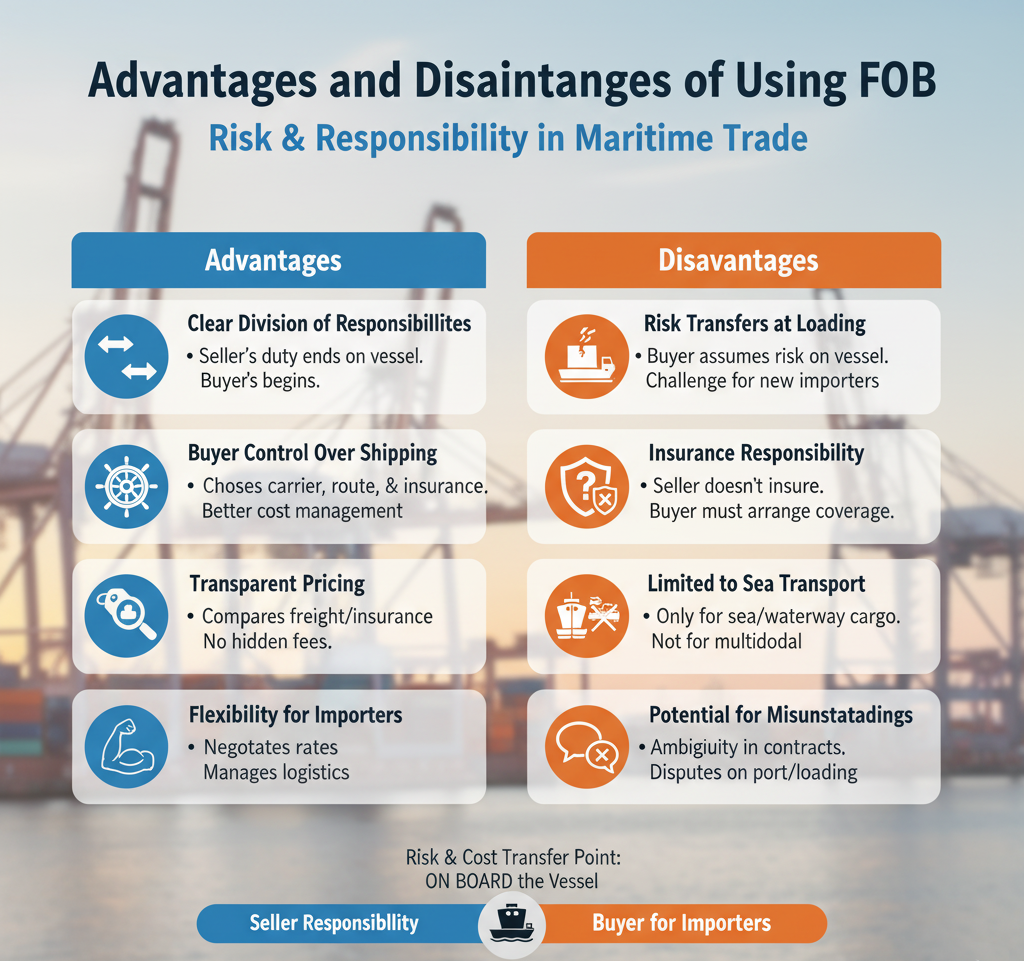
FOB (Free on Board) is one of the most widely used Incoterms in maritime trade, offering several benefits but also presenting certain challenges.
| Aspect | Advantages | Disadvantages |
|---|---|---|
| Responsibility | Clear division of duties between seller and buyer | Risk transfers to buyer once goods are loaded |
| Control | Buyer can choose carrier, route, and insurance | Buyer must arrange insurance independently |
| Pricing | Transparent; buyers can compare shipping costs separately | Limited to sea and inland waterway transport |
| Flexibility | Suitable for experienced importers to negotiate rates | Potential misunderstandings if contract is unclear |
Advantages:
- Clear Division of Responsibilities :FOB clearly defines the point where the seller’s responsibility ends and the buyer’s begins, reducing confusion and disputes.
- Buyer Control Over Shipping :The buyer can choose the carrier, shipping route, and insurance, allowing better control over cost and logistics.
- Transparent Pricing :Since FOB only covers costs up to loading, buyers can compare freight and insurance costs separately, ensuring transparency.
- Flexibility for Experienced Importers :Importers with shipping knowledge benefit from the freedom to negotiate rates and arrange transportation according to their needs.
Disadvantages:
- Risk Transfers at Loading :The buyer assumes all risk once goods are on the vessel, which can be a challenge for inexperienced importers.
- Insurance Responsibility on Buyer :Unlike CIF, the seller does not provide insurance, so the buyer must arrange coverage independently.
- Limited to Sea and Inland Waterway Transport :FOB is not suitable for multimodal shipments, making it less versatile than terms like FCA.
- Potential for Misunderstandings :If the contract is not clearly drafted, disputes may arise over the exact port of shipment or loading responsibilities.
Common Mistakes to Avoid in FOB Shipping Contracts
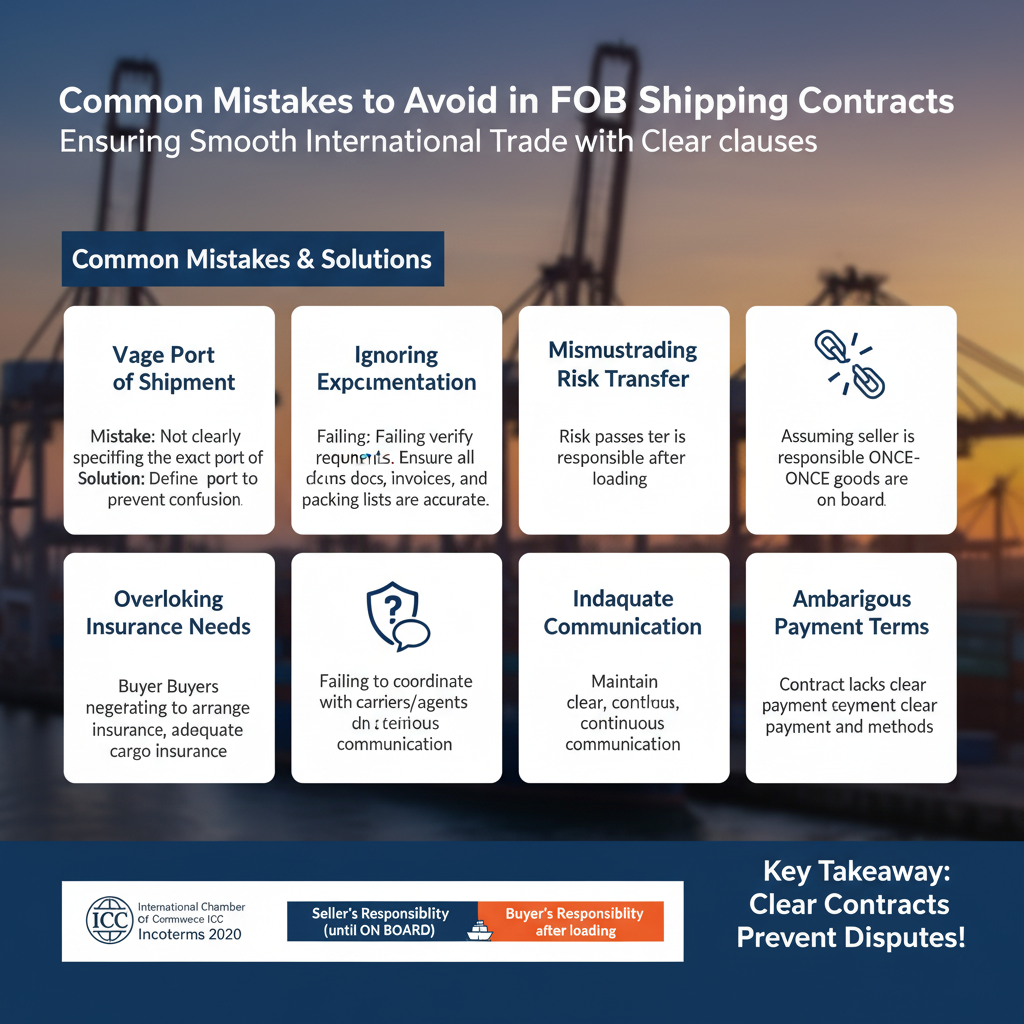
Using FOB (Free on Board) can simplify international trade, but errors in contracts often lead to disputes, delays, or unexpected costs. Here are the most common mistakes and how to avoid them:
1. Vague Port of Shipment
- Mistake: Not clearly specifying the exact port of loading.
- Solution: Always define the precise port in the contract to prevent confusion about risk transfer and shipping responsibilities.
2. Ignoring Export Documentation
- Mistake: Seller or buyer failing to verify required documents.
- Solution: Ensure all customs clearance documents, commercial invoices, and packing lists are accurate and complete.
3. Misunderstanding Risk Transfer
- Mistake: Assuming the seller is responsible for goods after loading.
- Solution: Both parties must understand that risk passes to the buyer once goods are on board.
4. Overlooking Insurance Needs
- Mistake: Buyers neglecting to arrange insurance, assuming the seller covers it (confusing FOB with CIF).
- Solution: Buyers should secure adequate cargo insurance for the entire journey.
5. Inadequate Communication
- Mistake: Failing to coordinate with carriers, port authorities, or shipping agents.
- Solution: Maintain clear, continuous communication to avoid delays and additional costs.
6. Ambiguous Payment Terms
- Mistake: Contract does not clearly define payment schedules or methods.
- Solution: Specify payment terms and accepted methods to prevent financial disputes.
By avoiding these mistakes, both buyers and sellers can ensure smooth FOB transactions, minimize risks, and maintain efficiency in international trade.
Real World Example: How FOB Works in a Sea Freight Transaction
To illustrate FOB (Free on Board) in practice, consider the following scenario:
Scenario: A furniture manufacturer in China sells a shipment of wooden chairs to a retailer in the United States under FOB (Free on Board) terms. Under this agreement, the seller is responsible for delivering the goods on board the vessel at the port of shipment in China. Once the chairs are loaded, all risks and costs of shipping from China to the US including ocean freight, insurance, and inland delivery are transferred to the buyer.
Seller’s Role
- The Chinese manufacturer prepares and packages the chairs for export.
- The goods are transported to the Port of Shanghai.
- The seller completes export customs clearance and loads the chairs onto the buyer’s nominated vessel.
Buyer’s Role
- The US retailer arranges ocean freight from Shanghai to the destination port in the US.
- They secure insurance to cover potential loss or damage during transit.
- Upon arrival, the buyer handles unloading, customs clearance, and delivery to their warehouse.
Key Takeaways from the Example:
- The risk transfers to the buyer as soon as the chairs are on board at Shanghai.
- The seller is not responsible for shipping costs or damages after loading.
- The buyer gains control over freight and insurance, allowing them to optimize costs and coverage.
This example shows how FOB provides clarity and balance: the seller focuses on export preparation, while the buyer manages international transport and associated risks.
Final Review: Is FOB the Right Choice for Your Business?
FOB (Free on Board) is a key Incoterm in maritime trade, offering clear responsibilities, transparent pricing, and flexibility.
It suits businesses that can manage shipping, insurance, and logistics themselves.
FOB is less ideal for those needing the seller to handle freight or multimodal transport.
Overall, FOB provides control and efficiency, but buyers and sellers must understand risk transfer and cost responsibilities.
FAQs: Free on board
What does FOB mean in shipping terms?
FOB (Free on Board) means the seller is responsible for the goods until they are loaded onto the vessel at the port of shipment, after which the buyer assumes risk and cost.
Who pays for shipping on FOB?
The buyer pays for ocean freight and any costs after the goods are loaded on the vessel.
Does FOB mean free freight?
No. FOB does not include freight. “Free on Board” only covers costs up to loading the goods on the ship.
Should I sell CIF or FOB?
FOB: If the buyer wants control over shipping and insurance.
CIF: If you, as the seller, prefer to handle freight and minimum insurance.
Who pays for FOB shipping?
The buyer pays for shipping from the port of shipment to the destination.
Who pays duty for FOB?
The buyer is responsible for import duties, taxes, and customs clearance at the destination country.
